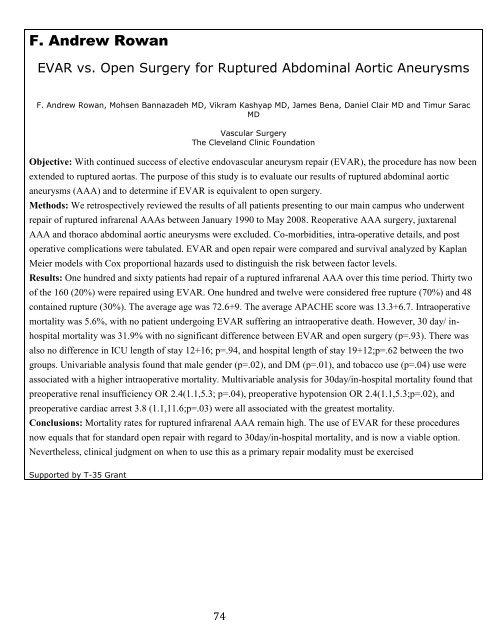student research day - Case Western Reserve University School of ...
student research day - Case Western Reserve University School of ...
student research day - Case Western Reserve University School of ...
Create successful ePaper yourself
Turn your PDF publications into a flip-book with our unique Google optimized e-Paper software.
F. Andrew Rowan<br />
EVAR vs. Open Surgery for Ruptured Abdominal Aortic Aneurysms<br />
F. Andrew Rowan, Mohsen Bannazadeh MD, Vikram Kashyap MD, James Bena, Daniel Clair MD and Timur Sarac<br />
MD<br />
Vascular Surgery<br />
The Cleveland Clinic Foundation<br />
Objective: With continued success <strong>of</strong> elective endovascular aneurysm repair (EVAR), the procedure has now been<br />
extended to ruptured aortas. The purpose <strong>of</strong> this study is to evaluate our results <strong>of</strong> ruptured abdominal aortic<br />
aneurysms (AAA) and to determine if EVAR is equivalent to open surgery.<br />
Methods: We retrospectively reviewed the results <strong>of</strong> all patients presenting to our main campus who underwent<br />
repair <strong>of</strong> ruptured infrarenal AAAs between January 1990 to May 2008. Reoperative AAA surgery, juxtarenal<br />
AAA and thoraco abdominal aortic aneurysms were excluded. Co-morbidities, intra-operative details, and post<br />
operative complications were tabulated. EVAR and open repair were compared and survival analyzed by Kaplan<br />
Meier models with Cox proportional hazards used to distinguish the risk between factor levels.<br />
Results: One hundred and sixty patients had repair <strong>of</strong> a ruptured infrarenal AAA over this time period. Thirty two<br />
<strong>of</strong> the 160 (20%) were repaired using EVAR. One hundred and twelve were considered free rupture (70%) and 48<br />
contained rupture (30%). The average age was 72.6+9. The average APACHE score was 13.3+6.7. Intraoperative<br />
mortality was 5.6%, with no patient undergoing EVAR suffering an intraoperative death. However, 30 <strong>day</strong>/ in-<br />
hospital mortality was 31.9% with no significant difference between EVAR and open surgery (p=.93). There was<br />
also no difference in ICU length <strong>of</strong> stay 12+16; p=.94, and hospital length <strong>of</strong> stay 19+12;p=.62 between the two<br />
groups. Univariable analysis found that male gender (p=.02), and DM (p=.01), and tobacco use (p=.04) use were<br />
associated with a higher intraoperative mortality. Multivariable analysis for 30<strong>day</strong>/in-hospital mortality found that<br />
preoperative renal insufficiency OR 2.4(1.1,5.3; p=.04), preoperative hypotension OR 2.4(1.1,5.3;p=.02), and<br />
preoperative cardiac arrest 3.8 (1.1,11.6;p=.03) were all associated with the greatest mortality.<br />
Conclusions: Mortality rates for ruptured infrarenal AAA remain high. The use <strong>of</strong> EVAR for these procedures<br />
now equals that for standard open repair with regard to 30<strong>day</strong>/in-hospital mortality, and is now a viable option.<br />
Nevertheless, clinical judgment on when to use this as a primary repair modality must be exercised<br />
Supported by T-35 Grant<br />
74
















